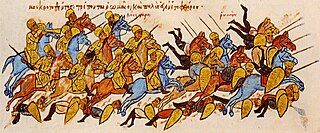The 880s decade ran from January 1, 880, to December 31, 889.
The 900s decade ran from January 1, 900, to December 31, 909.
The 920s decade ran from January 1, 920, to December 31, 929.

Year 899 (DCCCXCIX) was a common year starting on Monday of the Julian calendar.

Year 885 (DCCCLXXXV) was a common year starting on Friday of the Julian calendar.

Year 900 (CM) was a leap year starting on Tuesday of the Julian calendar.

Year 896 (DCCCXCVI) was a leap year starting on Thursday of the Julian calendar.

Year 904 (CMIV) was a leap year starting on Sunday of the Julian calendar.

Year 906 (CMVI) was a common year starting on Wednesday of the Julian calendar.

Year 908 (CMVIII) was a leap year starting on Friday of the Julian calendar.

Year 895 (DCCCXCV) was a common year starting on Wednesday of the Julian calendar.

Abū al-ʿAbbās Aḥmad ibn Ṭalḥa ibn Jaʿfar ibn Muḥammad ibn Hārūn, 853/4 or 860/1 – 5 April 902, better known by his regnal name al-Muʿtaḍid bi-llāh, was the caliph of the Abbasid Caliphate from 892 until his death in 902.

Abū Muḥammad ʿAlī ibn Aḥmad ibn Ṭalḥa ibn Jaʿfar ibn Muḥammad ibn Hārūn al-Muktafī bi'Llāh, better known by his regnal name al-Muktafī bi-Llāh, was the caliph of the Abbasid Caliphate from 902 to 908. More liberal and sedentary than his militaristic father al-Mu'tadid, al-Muktafi essentially continued his policies, although most of the actual conduct of government was left to his viziers and officials. His reign saw the defeat of the Qarmatians of the Syrian Desert, and the reincorporation of Egypt and the parts of Syria ruled by the Tulunid dynasty. The war with the Byzantine Empire continued with alternating success, although the Arabs scored a major victory in the Sack of Thessalonica in 904. His death in 908 opened the way for the installation of a weak ruler, al-Muqtadir, by the palace bureaucracy, and began the terminal decline of the Abbasid Caliphate that ended in 946 with the caliphs becoming puppet rulers under the Buyid dynasty.

Abū’l-Faḍl Jaʿfar ibn Aḥmad ibn Ṭalḥa ibn Jaʿfar ibn Muḥammad ibn Hārūn Al-Muqtadir bi'Llāh, better known by his regnal name al-Muqtadir bi'Llāh, was the eighteenth caliph of the Abbasid Caliphate from 908 to 932 AD, with the exception of a brief deposition in favour of al-Qahir in 929.
Muhammad ibn Ishaq ibn Kundaj was a prominent general of the Abbasid Caliphate in the early 10th century.
Ibn al-Ikhshad or Ibn al-Ikhshid was the governor of Tarsus for the Abbasid Caliphate from April 898 until his death in battle against the Byzantines in early 900.
Ṭughj ibn Juff ibn Yiltakīn ibn Fūrān ibn Fūrī ibn Khāqān was a Turkic military officer who served the Abbasid Caliphate and the autonomous Tulunids. He was the father of Muhammad al-Ikhshid, the founder of the Ikhshidid dynasty.
Isa ibn Muhammad al-Nushari or Isa ibn Musa al-Nushari was an Abbasid commander and governor of Isfahan in 896–900 and of Egypt from 905 to his death in spring 910.
Badr ibn ʿAbdallāh al-Ḥammāmī also known as Badr al-Kabīr, was a general who served the Tulunids and later the Abbasids.
Asma bint Khumarawayh ibn Ahmad ibn Tulun, better known as Qatr al-Nada, was a daughter of Tulunid vassal ruler Khumarawayh ibn Ahmad and the principal wife of the sixteenth Abbasid caliph, al-Mu'tadid.











